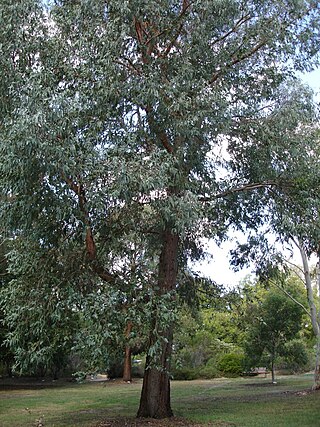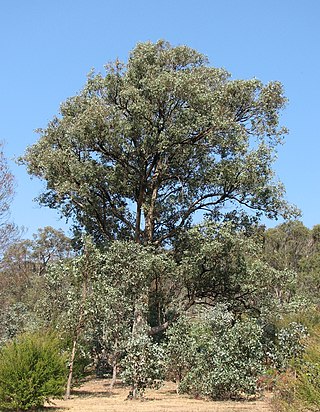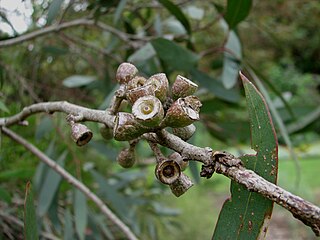
Eucalyptus microcorys, commonly known as tallowwood, is a species of medium to tall tree that is endemic to eastern Australia. It has rough, fibrous or string bark on the trunk and branches, lance-shaped to egg-shaped adult leaves, flower buds in groups of seven or nine, white to lemon-yellow flowers and conical fruit. It grows in forests near the coast of Queensland and New South Wales.

Eucalyptus morrisbyi, commonly known as Morrisby's gum, is a species of small to medium-sized tree that is endemic to a restricted area of Tasmania. It has loose slabs of rough bark near the base of its trunk, smooth pale grey bark above, lance-shaped to egg-shaped adult leaves, flower buds in groups of three, white flowers and barrel-shaped or cylindrical fruit. It is only known in the wild from a few small populations but has been widely planted as an ornamental.

Eucalyptus chapmaniana, commonly known as the Bogong gum, is a species of small to medium-sized tree endemic to montane and eastern Australia. It has rough, fibrous and fissured bark on most of the trunk and smooth light brown to grey bark often shed in long ribbons on the branches. The adult leaves are lance-shaped to curved, the flower buds in groups of three and the fruit a conical or bell-shaped capsule.

Eucalyptus polyanthemos, commonly known as red box, is a species of small to medium-sized tree, that is native to eastern Australia but has been introduced into other countries. It has fibrous bark on the trunk and larger branches, smooth greyish to cream-coloured bark above, or smooth bark throughout. It has broadly egg-shaped to round juvenile leaves, lance-shaped, egg-shaped or almost round adult leaves, flower buds in groups of seven, white flowers and barrel-shaped to conical fruit.

Eucalyptus angophoroides, commonly known as the apple-topped box, apple box or apple gum, is a tree endemic to south-eastern Australia. It has rough, flaky or fibrous bark on its trunk and larger branches, lance-shaped adult leaves, white flowers and conical to hemispherical fruit.

Eucalyptus parvula, commonly known as small-leaved gum, is a species of small tree that is endemic to south-eastern New South Wales. It has mostly smooth bark, elliptical to lance-shaped adult leaves but with many juvenile of intermediate leaves in the crown, flower buds in groups of seven, white flowers and cup-shaped fruit.

Eucalyptus brookeriana, commonly known as Brooker's gum, is a tree species that is endemic to south-eastern Australia. It has rough, fibrous bark on the lower part of its trunk, smooth bark higher up, lance-shaped, egg-shaped or curved adult leaves, flower buds usually arranged in groups of seven, white flowers and cup-shaped, conical or bell-shaped fruit.

Eucalyptus yarraensis, commonly known as Yarra gum, is a tree species that is endemic to Victoria, Australia. It has rough bark on the trunk and larger branches, lance-shaped to elliptical or egg-shaped adult leaves, flower buds in groups of seven, white flowers and conical fruit. In 2021 the Victorian Government listed it as critically endangered under the Flora and Fauna Guarantee Act.

Eucalyptus kartzoffiana, commonly known as the Araluen gum, is a species of medium-sized tree that is endemic to a small area of southeastern New South Wales. It has rough, fibrous or flaky bark on part or most of its trunk, lance-shaped or curved adult leaves, flower buds in groups of three, white flowers and sessile, bell-shaped fruit.

Eucalyptus walshii is a small, slender, pole-like tree that is endemic to Victoria, Australia. It has smooth bark, lance-shaped to egg-shaped adult leaves, flower buds in groups of seven to eleven, white flowers and cup-shaped fruit.

Eucalyptus chloroclada, commonly known as Baradine gum, red gum or dirty gum, is a species of small to medium-sized tree that is endemic to eastern Australia. It usually has fibrous to flaky bark on the trunk and smooth bark above, lance-shaped adult leaves, flower buds in groups of seven, white flowers and hemispherical fruit.

Eucalyptus dunnii, commonly known as Dunn's white gum or simply white gum, is a species of medium-sized to tall tree that is endemic to eastern Australia. It has rough bark near the base, smooth white to cream-coloured bark above, lance-shaped to curved adult leaves, flower buds in groups of seven, white flowers and cup-shaped, conical or hemispherical fruit.

Eucalyptus griffithsii, commonly known as Griffith's grey gum, is a species of mallee or tree that is endemic to Western Australia. It has smooth grey to whitish bark, sometimes with rough, loose fibrous bark near the base of the trunk, lance-shaped adult leaves, flower buds in groups of three, white flowers and conical to cup-shaped fruit.
Eucalyptus pruiniramis, commonly known as Jingymia gum or midlands gum is a species of mallee or tree that is endemic to a small area of Western Australia. It usually has rough bark on the lower half of the trunk, smooth bark above, dull green, lance-shaped adult leaves, flower buds in groups of between seven and eleven, white flowers and cylindrical to cup-shaped fruit.

Eucalyptus striaticalyx, commonly known as Cue York gum or kopi gum, is a species of tree or mallee that is endemic to Western Australia. It has thick, rough, fibrous bark on the trunk and larger branches, lance-shaped adult leaves, flower buds in groups of between seven and thirteen, creamy white flowers and conical to cup-shaped fruit.

Eucalyptus uncinata, commonly known as the hook-leaved mallee, is a species of mallee that is endemic to the southwest of Western Australia. It has smooth bark, lance-shaped adult leaves, flower buds arranged in groups of nine to thirteen, creamy white flowers and barrel-shaped to oval or cylindrical fruit.

Eucalyptus neglecta, commonly known as Omeo gum, is a species of small tree that is endemic to a small area of Victoria, Australia. Older plants have rough, fibrous bark on the trunk, otherwise smooth grey to brownish bark, a crown of mostly lance-shaped, egg-shaped or oblong leaves arranged in opposite pairs, flower buds in groups of between seven and fifteen, white flowers and cup-shaped or conical fruit.

Eucalyptus petiolaris, commonly known as Eyre Peninsula blue gum, water gum or blue gum, is a species of small to medium-sized tree that is endemic to South Australia. It is also naturalised in Western Australia. It has rough, flaky bark on the trunk, smooth greyish bark above, lance-shaped adult leaves, flower buds in groups of three, cream-coloured, yellow, pink or red flowers and cup-shaped or barrel-shaped fruit.
Eucalyptus pyrenea, commonly known as Pyrenees gum, is a species of tree that is endemic to Victoria, Australia. It has smooth, greyish bark with rough, fibrous bark on the lower part of the trunk, lance-shaped to curved adult leaves, flower buds in groups of seven, white flowers and cup-shaped fruit.
Eucalyptus litoralis, commonly known as Anglesea box, is a species of tree that is endemic to a small area in Victoria. It has rough but thin, fibrous bark on the trunk, smooth pale grey bark on the branches, lance-shaped to curved adult leaves, flower buds in groups of seven, white flowers and cup-shaped or barrel-shaped fruit.

















